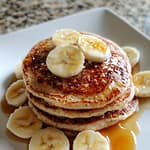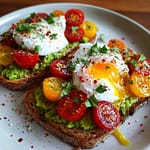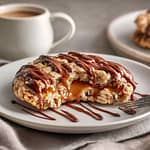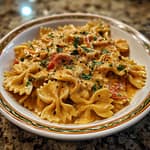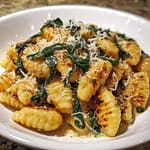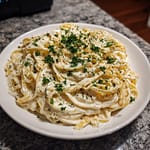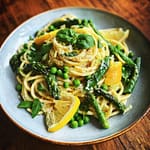Soft, airy, and slightly crispy with a delicate glaze—French crullers are a treat that stands apart from the average donut. Known for their light texture and elegant ridges, these French-style pastries have gained a cult following across donut lovers in the U.S. and beyond. But what makes a French cruller different from a regular donut? Why did some major chains discontinue them? Can you still enjoy one at home? This article breaks down everything you need to know—from origins and ingredients to how to make your own.
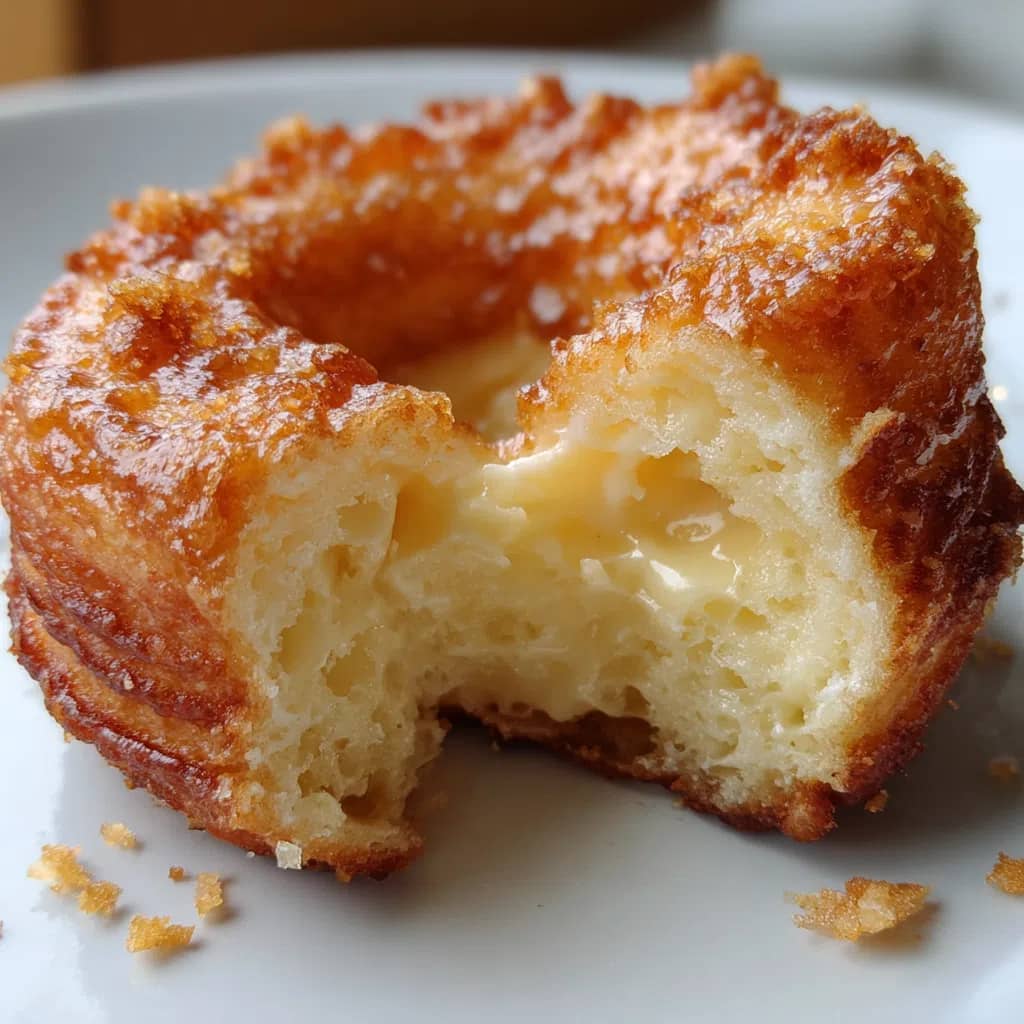
Let’s dive into the story, taste, and techniques behind the beloved French cruller.
What Is a French Cruller?
Ever spotted a doughnut that looks like a twisted ring and wondered what it’s called? That’s a French cruller, and it’s one of the lightest treats in the doughnut family.
- What Makes a French Cruller Unique Compared to a Regular Doughnut?*
Crullers sound fancy, but they win you over with their feather-light bite. Sure, they’re fried, sweet, and shaped like a doughnut, but the first taste shows you they aren’t following the same rules. See, regular doughnuts can be thick and cakey. A cruller, by contrast, hardly feels like food – it practically floats.
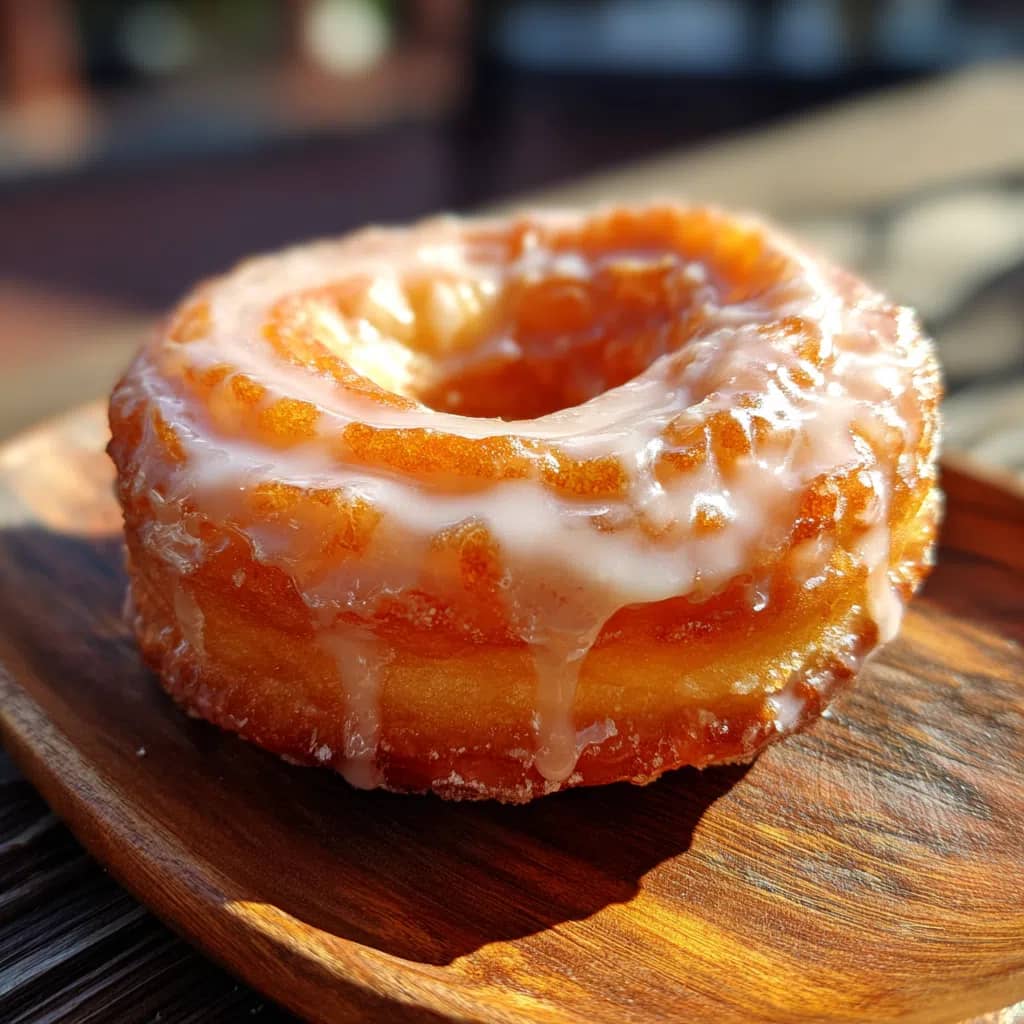
Cruller vs. Donut: Texture, Shape & Ingredients
So let’s get real—how does a French cruller stack up next to a regular donut? Here’s a down-to-earth breakdown:
Related Posts
-
Easy Pancake Recipe No Milk (Perfect for All...pancake recipe no milk When you're craving pancakes but find yourself without milk—or simply avoiding…
-
Fluffy Whole Wheat Banana PancakesStart your morning right with these easy, healthy, and fluffy banana pancakes made with whole…
-
Creamy Avocado Toast with Poached Egg and Cherry...Introduction Creamy, fresh, and packed with vibrant colors, this avocado toast recipe takes a beloved…
The dough: crullers use choux pastry. That’s cooked on the stovetop before you even fry it. Regular donuts? Usually yeast dough or a thick cake batter.
The texture: Crullers are puffier, lighter, almost hollow in the middle. Regular donuts are denser or bread-like.
The taste: Crullers are mildly sweet and have this egg-forward flavour. Traditional donuts are sweeter, sometimes too sweet.
Related Posts
-
Easy Pancake Recipe No Milk (Perfect for All...pancake recipe no milk When you're craving pancakes but find yourself without milk—or simply avoiding…
-
Fluffy Whole Wheat Banana PancakesStart your morning right with these easy, healthy, and fluffy banana pancakes made with whole…
-
Creamy Avocado Toast with Poached Egg and Cherry...Introduction Creamy, fresh, and packed with vibrant colors, this avocado toast recipe takes a beloved…
The shape: Crullers have those twisted ridges, usually from a star-shaped piping tip. Donuts? Just smooth rings—or sometimes round with jam or cream.
You’ll feel the difference the moment you pick it up. A cruller feels soft, almost fragile. And when you bite into it, it kind of pulls apart instead of crumbling or stretching.
What Is a Cruller Made Of? Choux Pastry Basics
Choux pastry (say it like shoe) is the heart and soul of every good French cruller. It’s not like any regular dough. You don’t knead it. You don’t let it rise. Instead, you cook it.
Yep—you cook the dough.
Here’s what goes in:
- Butter
- Water
- Flour
- A pinch of salt
- Then eggs—lots of them
You melt the butter in simmering water, dump in the flour, and stir hard till it forms a soft, smooth ball. After that you crack in the eggs, one by one. At first the batter looks lumpy, but keep mixing and it turns glossy and thick. Now it’s time to pipe rings and hit the hot oil.
The magic puff comes from steam trapped inside. There’s no yeast and no baking powder needed, just hot oil and a little food science.
Is It Pronounced Crawler or Cruller? Understanding the Name
People mess this up all the time. You’ve probably heard someone call it a crawler. But technically it’s pronounced cruh-ler—kind of like the word fuller, only with a C.
Where does the name come from? Turns out it’s got Dutch roots. The word krullen means to curl, which totally makes sense once you see the spiral shape. Early cooks twisted each donut by hand before frying. These days we pipe them with a star tip to get those pretty ridges.
Sure, its name isn’t actually “crawler.” But you know what? Call it whatever sounds right to you. Just promise you’ll grab one and dig in while you’re here.
History and Origins
Where Does the French Cruller Come From?
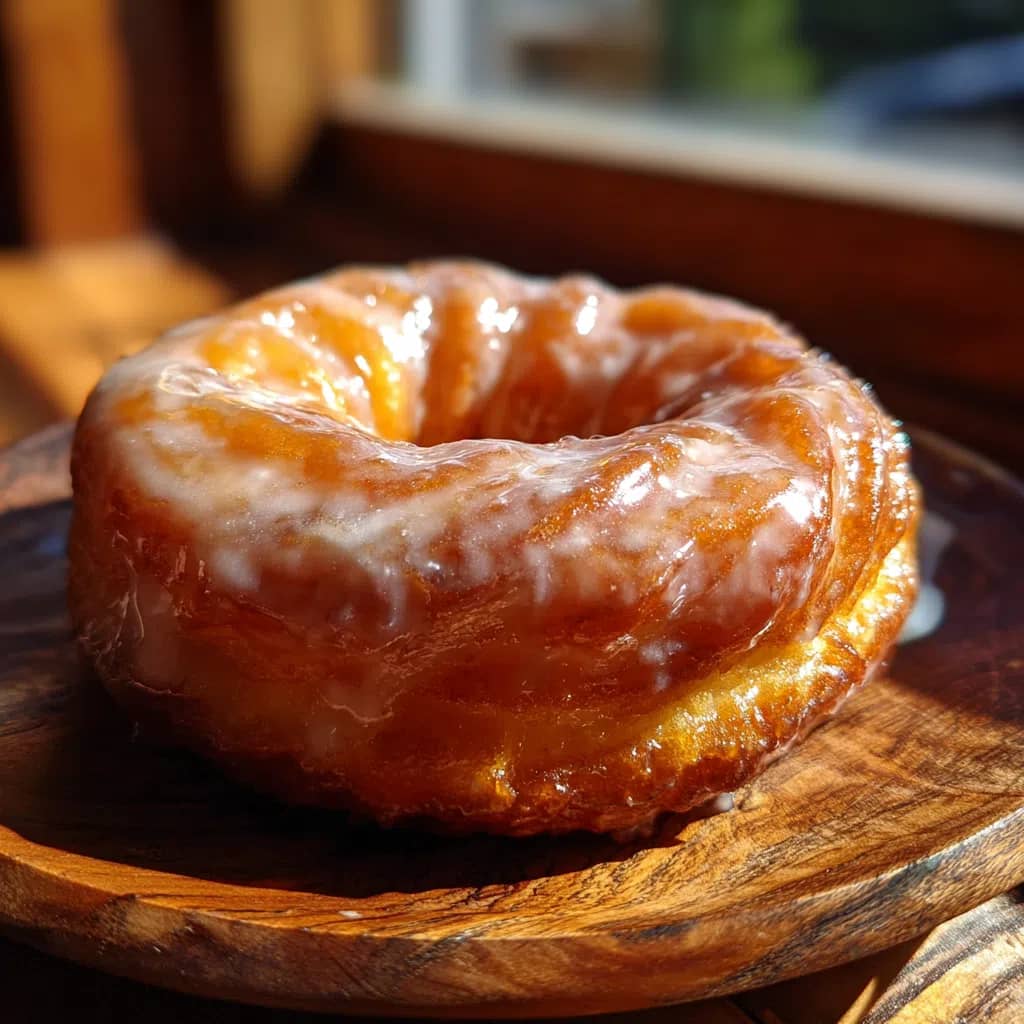
Despite what the name suggests, the French cruller isn’t strictly a French invention—it’s more of a delicious mash-up between French technique and American creativity. The foundation of the cruller lies in pâte à choux, a classic French pastry dough that dates back to the 16th century.
But the version we bite into today? That’s an American bakery twist, where the choux dough is piped into circles, fried until golden, and finished with a glossy sugar glaze. The result? A French-inspired donut that became a staple in U.S. donut shops throughout the 20th century.
Some historians trace the cruller’s influence back to the Dutch settlers in early America, who made fried twisted pastries called “krullers.” Over time, French pastry methods—especially choux-based ones—merged with this tradition, giving rise to the modern donut we know today.
Print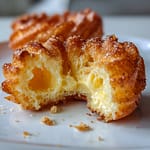
French Cruller – The Fluffy Donut with a French Twist
- Total Time: 40 minutes
- Yield: 8 crullers
- Diet: Vegetarian
Description
French crullers are light, airy donuts made from choux pastry and fried until golden, then topped with a sweet vanilla glaze. Perfect for breakfast or brunch, they offer a crisp outside and a custardy center that melts in your mouth.
Ingredients
- ½ cup water
- ½ cup whole milk
- ½ cup unsalted butter
- 1 tablespoon sugar
- ¼ teaspoon salt
- 1 cup all-purpose flour
- 4 large eggs
- Vegetable oil for frying
- 1½ cups powdered sugar
- 3 tablespoons milk
- ½ teaspoon vanilla extract
Instructions
- In a saucepan, heat water, milk, butter, sugar, and salt until boiling.
- Add flour and stir vigorously until the dough pulls away from the pan sides.
- Cool slightly, then add eggs one at a time until smooth and glossy.
- Transfer dough to a piping bag with a star tip. Pipe rings onto parchment squares.
- Fry in 375°F oil until puffed and golden. Drain on paper towels.
- Dip each cruller in vanilla glaze and let set.
Notes
- Use a thermometer to control frying temperature.
- You can bake them at 425°F if you prefer less oil.
- Try lemon or maple glaze for variation.
- Prep Time: 15 minutes
- Cook Time: 25 minutes
- Category: Breakfast
- Method: Frying
- Cuisine: French-American
Nutrition
- Serving Size: 1 cruller
- Calories: 260
- Sugar: 11 g
- Sodium: 160 mg
- Fat: 16 g
- Saturated Fat: 6 g
- Unsaturated Fat: 9 g
- Trans Fat: 0 g
- Carbohydrates: 25 g
- Fiber: 0 g
- Protein: 3 g
- Cholesterol: 125 mg
Why Is It Called a this light donut? Name & Influence
The name “French cruller” brings two worlds together.
- “French” refers to the dough—choux pastry, which is famously French in origin.
- “Cruller” comes from the Dutch word krullen, meaning “to curl” or “twist.”
Originally, crullers were twisted by hand into braided or curled shapes before frying. With the introduction of choux pastry, bakers began using star-tipped piping bags to create the signature ridged, circular rings that define French crullers today.
So really, the name tells the whole story: a French-style dough shaped like a traditional cruller. Simple, honest, and accurate.
Through the Years: Popularity Across Cultures
French crullers saw their golden age in American bakeries—especially in the mid to late 20th century. Major chains like Dunkin’ Donuts and Krispy Kreme helped make them a familiar treat across the U.S.
They weren’t just popular for their flavor. Crullers stood out on the shelf, thanks to their elegant ridges and lighter-than-air look. Customers loved how different they felt compared to heavy cake or filled donuts.
In recent years, though, some large chains discontinued them (we’ll cover why in Part 5). But at the same time, there’s been a resurgence of artisan baking and nostalgia-driven food trends. That’s led to a growing number of local bakeries and home bakers reviving the donut, making it a comeback pastry in 2025 and beyond.
From their European roots to their American reinvention, French crullers have held onto one timeless truth: everyone loves a light, golden, sweet treat that’s just a little bit fancy.
History and Origins
Where Does the the airy pastr Come From?
Despite what the name suggests, the French cruller isn’t strictly a French invention—it’s more of a delicious mash-up between French technique and American creativity. The foundation of the cruller lies in pâte à choux, a classic French pastry dough that dates back to the 16th century.
But the version we bite into today? That’s an American bakery twist, where the choux dough is piped into circles, fried until golden, and finished with a glossy sugar glaze. The result? A French-inspired donut that became a staple in U.S. donut shops throughout the 20th century.
Some historians trace the cruller’s influence back to the Dutch settlers in early America, who made fried twisted pastries called “krullers.” Over time, French pastry methods—especially choux-based ones—merged with this tradition, giving rise to the modern French cruller donut we know today.
Why Is It Called a French Cruller? Name & Influence
The name “French cruller” brings two worlds together.
- “French” refers to the dough—choux pastry, which is famously French in origin.
- “Cruller” comes from the Dutch word krullen, meaning “to curl” or “twist.”
Originally, crullers were twisted by hand into braided or curled shapes before frying. With the introduction of choux pastry, bakers began using star-tipped piping bags to create the signature ridged, circular rings that define French crullers today.
So really, the name tells the whole story: a French-style dough shaped like a traditional cruller. Simple, honest, and accurate.
Through the Years: Popularity Across Cultures
French crullers saw their golden age in American bakeries—especially in the mid to late 20th century. Major chains like Dunkin’ Donuts and Krispy Kreme helped make them a familiar treat across the U.S.
They weren’t just popular for their flavor. Crullers stood out on the shelf, thanks to their elegant ridges and lighter-than-air look. Customers loved how different they felt compared to heavy cake or filled donuts.
In recent years, though, some large chains discontinued them (we’ll cover why in Part 5). But at the same time, there’s been a resurgence of artisan baking and nostalgia-driven food trends. That’s led to a growing number of local bakeries and home bakers reviving the donut, making it a comeback pastry in 2025 and beyond.
From their European roots to their American reinvention, French crullers have held onto one timeless truth: everyone loves a light, golden, sweet treat that’s just a little bit fancy.
How to Make a Classic this glazed ring
Ingredients for recipe: What You’ll Need
You don’t need anything fancy to make a real French cruller at home. The beauty of this recipe is how basic and simple the ingredients are, yet how elegant and bakery-worthy the result tastes.
Here’s what goes into the choux dough:
- ½ cup water
- ½ cup whole milk
- ½ cup unsalted butter
- 1 tablespoon sugar
- ¼ teaspoon salt
- 1 cup all-purpose flour
- 4 large eggs
For frying:
- Vegetable oil (or any neutral frying oil)
For the glaze:
- 1½ cups powdered sugar
- 3 tablespoons milk
- ½ teaspoon vanilla extract
All of these ingredients are pantry staples, which means you could be just one craving away from homemade French crullers.
Step-by-Step Cooking Method for Making classic choux treat at Home
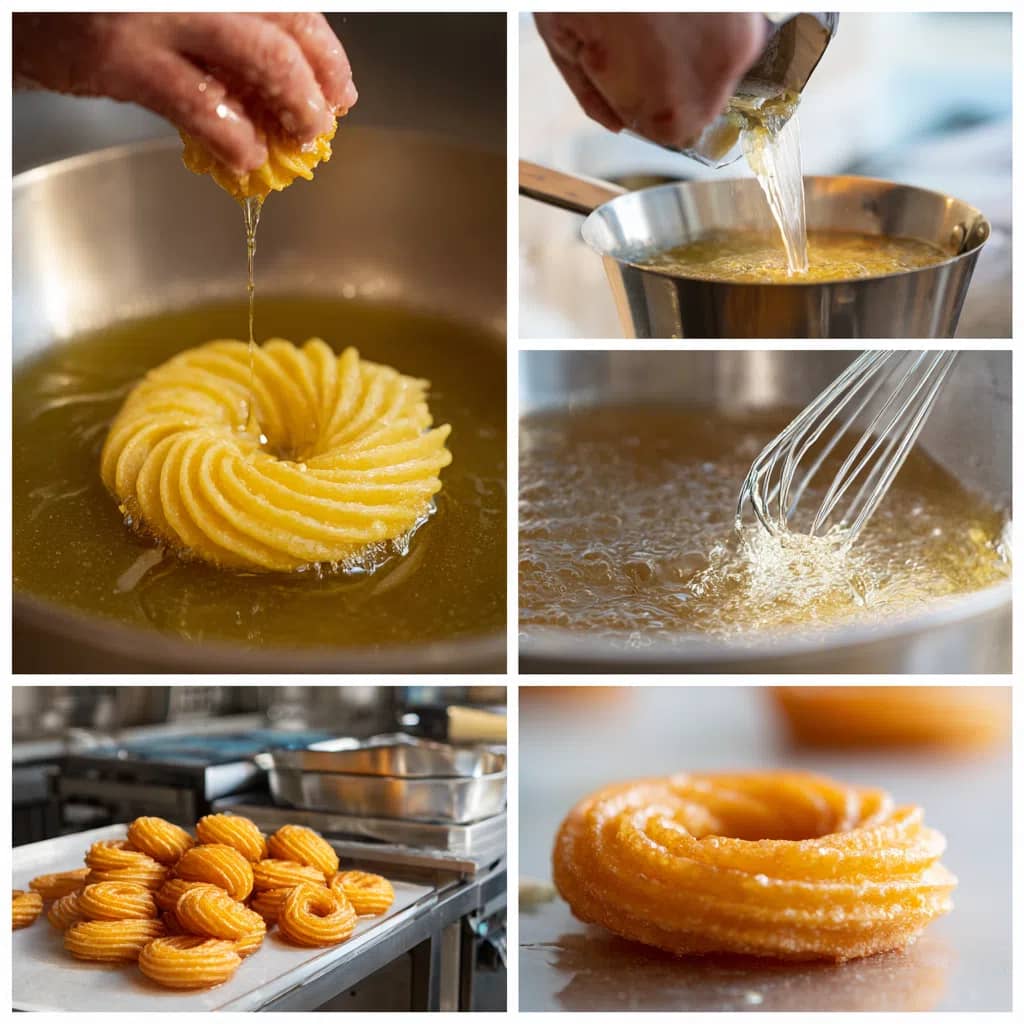
Making French crullers sounds fancy, but it’s actually easier than you’d think. The only thing you need to be careful with? Temperature control and mixing order.
Let’s walk through it:
Step 1: Cook the Choux Pastry Dough
In a medium saucepan, combine the water, milk, butter, sugar, and salt over medium heat. Bring to a gentle boil, making sure the butter melts completely.
As soon as the mixture bubbles, add in the flour all at once and stir vigorously with a wooden spoon or silicone spatula. The dough will come together quickly and start to pull away from the sides of the pot.
Keep cooking and stirring for about 1 minute until the dough forms a soft ball and leaves a light film at the bottom of the pan. That film means it’s ready.
Step 2: Add the Eggs One at a Time
Transfer the dough to a mixing bowl and let it cool for 5 minutes. You don’t want to cook the eggs!
Then, beat in the eggs one at a time, mixing thoroughly between each addition. The dough may look broken or lumpy at first, but it will smooth out. By the end, you’ll have a shiny, thick batter that holds its shape when piped.
Step 3: Pipe the Dough into Rings
Spoon the dough into a piping bag fitted with a large star tip. On small squares of parchment paper, pipe rings about 3 to 4 inches wide.
Pro tip: Use a cookie cutter or glass to trace circles as guides on the paper for consistent sizing.
Step 4: Fry Until Golden and Puffy
Heat your frying oil to 375°F (190°C). Gently drop each parchment paper with piped dough into the hot oil—dough side down.
After 10–15 seconds, use tongs to pull out the parchment and continue frying the cruller. Cook for about 2–3 minutes per side, until golden brown and puffed.
Don’t overcrowd the pot. Fry in batches to maintain oil temperature and consistent cooking.
Once done, transfer the crullers to a paper towel-lined cooling rack.
Step 5: Glaze and Serve
In a small bowl, whisk together powdered sugar, milk, and vanilla until smooth.
Dip each warm cruller into the glaze, turning to coat fully. Let the excess drip off, then return to a wire rack to set.
The glaze will firm up slightly as it cools—giving that shiny, slightly crunchy coating that melts on your tongue.
Are Crullers Baked or Fried? Cooking Methods Explained
Traditionally, crullers are fried. That’s what gives them the crispy ridges and puffed texture that choux pastry is famous for.
But can you bake them? Yes—technically you can. Baked crullers won’t have the same crisp bite or deep golden color, but if you’re avoiding fried foods, you can pipe them onto a lined tray and bake at 425°F (220°C) for 10–12 minutes, then reduce to 375°F (190°C) for another 10 minutes.
Still, if you want that classic French bakery-style flavor and feel, frying is the way to go.
Topping & Glazing Tips: Sugar, Icing & More
The standard glaze is classic: vanilla, sugar, and milk. But there’s room to experiment.
Try these variations:
| Flavor | Add-ins |
|---|---|
| Maple glaze | Add 1 tsp maple extract |
| Lemon glaze | Add 1 tsp lemon zest + ½ tsp juice |
| Chocolate dip | Melt chocolate + 1 tsp butter |
| Cinnamon sugar | Skip the glaze and toss in cinnamon-sugar while warm |
Let the glaze set slightly before serving. Or eat them still-warm and dripping—you decide.
✅ Bonus Tip: Mastering the Texture
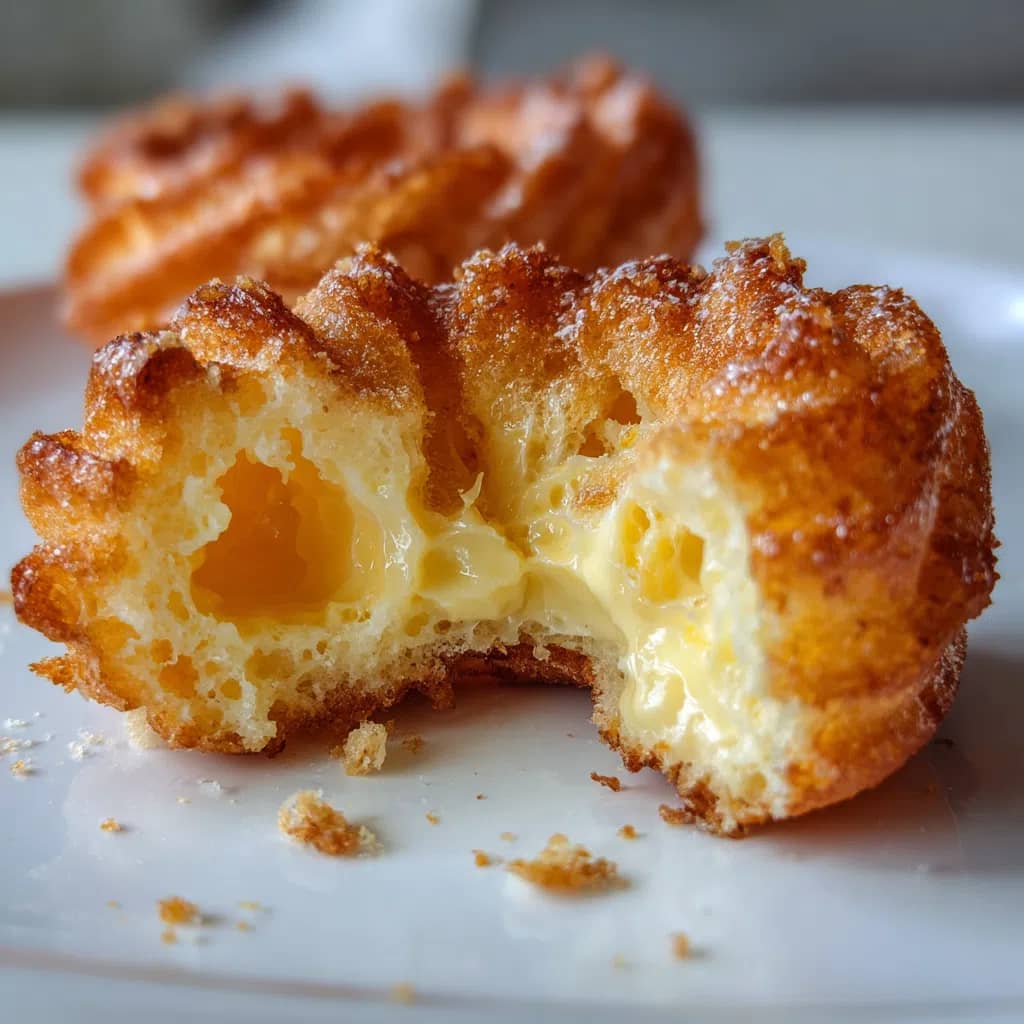
The real charm of a cruller donut lies in its texture. If your oil is too cool, you’ll get greasy crullers. Too hot, and they’ll burn on the outside while staying raw inside.
Always use a thermometer to maintain 375°F, and don’t walk away while frying.
Nutrition Facts & Flavor Profile
What Does a Taste Like?
Light, eggy, crisp, and just sweet enough—the French cruller offers a texture and flavor that feels almost too elegant to be a donut.
The outer ridges are lightly crisp, thanks to the choux pastry hitting hot oil. Inside, it’s soft and custard-like, almost melting in your mouth with each bite. It doesn’t punch you in the face with sugar like other donuts. Instead, it whispers sweetness through a thin vanilla glaze that clings to every ridge.
If you’re used to yeast donuts that are heavy and chewy or cake donuts that are dense and rich, the cruller feels like biting into a pastry cloud—no grease overload, no sugar fatigue. Just light, pillowy satisfaction with a slightly egg-forward profile.
No wonder many describe it as the croissant of the donut world.
Calories in a soft custard-style donut: What You Should Know
lightest donuts calorie-wise, but they’re still a treat. A standard glazed bakery-style ring contains about 220–270 calories depending on size and glaze thickness.
Here’s a quick nutrition estimate for one medium-sized glazed cruller:
| Nutrient | Amount (approx) |
|---|---|
| Calories | 260 kcal |
| Total Fat | 16g |
| Saturated Fat | 6g |
| Cholesterol | 125mg |
| Carbohydrates | 25g |
| Sugars | 11g |
| Protein | 3–4g |
| Sodium | 160mg |
These values can vary if you use a thicker glaze, fry in different oils, or make the crullers extra large.
Still, compared to a Bavarian cream donut (400+ calories) or a frosted cake donut (350+ calories), the cruller is a lighter indulgence.
How Much Sugar Is in a this light donut?
Crullers are generally lower in sugar than traditional donuts. One glazed this light donut usually contains around 10–12 grams of sugar.
That’s mostly from the vanilla glaze, which adds sweetness without overpowering the mild flavor of the choux pastry.
If you want to reduce sugar:
- Use a lighter drizzle of glaze
- Opt for baking instead of frying
- Try a cinnamon dusting instead of icing
But honestly, the glaze is half the magic—it seeps into every ridge, delivering flavor with each bite.
Can French Crullers Fit Into a Balanced Diet?
Yes—if eaten in moderation, French crullers can easily be part of a balanced lifestyle. Here’s why:
- Lower fat than filled donuts
- Less sugar than frosted or sprinkled versions
- Lighter texture that satisfies without heaviness
They’re not a daily breakfast, but they’re not a calorie bomb either. Pair one with a coffee or tea for a special weekend treat, or serve them at brunch for guests.
For those watching carbs or fats, baking instead of frying can also shave off a few grams of fat, though you’ll sacrifice some crispness.
Want a lighter glaze? Try mixing powdered sugar with lemon juice or almond extract for a fresh twist that brightens flavor with less sweetness.
✅ Summary: Why the Cruller Wins in Taste and Nutrition
- Flavor: Eggy, light, never greasy
- Texture: Crisp outside, airy inside
- Calories: Lower than most donuts
- Sugar: Manageable and easy to adjust
- Satisfaction: High—without the post-donut slump
When it comes to indulgent yet refined pastry, the French cruller is hard to beat.
Availability & Discontinuation
Why Did Krispy Kreme and Dunkin’ Discontinue the this light donut?
If you’ve walked into a Dunkin’ Donuts or Krispy Kreme lately and couldn’t find your favorite French cruller, you’re not alone—and you’re definitely not the only one wondering why it disappeared.
Despite being a fan favorite, French crullers were quietly pulled from many locations. The reason? Production issues and shelf life.
Unlike yeast donuts, this light donut are fragile. Their airy choux pastry structure doesn’t hold up well for long hours on a display rack. They lose crispness quickly, become soggy with glaze, and just don’t age as well as more robust donuts.
Also, the dough itself—pâte à choux—is trickier to work with in large-scale operations. It requires more temperature control, more precise mixing, and can’t be prepped in bulk quite like yeast dough.
For chains focused on volume, speed, and consistency, the cruller became too delicate to maintain.
Does Dunkin’ Donuts Still Sell this light donut?
Yes… but only in some locations.
While French crullers were removed from many Dunkin’ menus, they occasionally pop up as regional specials or seasonal items. Some franchise owners still make them if there’s enough local demand.
Want to know if your local shop still has them? The best move is to call ahead—or better yet, make your own at home (you’ve got the recipe now!).
Where Can You Still Buy French Crullers in 2025?
Though the big chains may have scaled back, you can still find amazing French crullers at local bakeries across the U.S.
Here are a few options worth checking:
- Independent donut shops: Many pride themselves on traditional, made-from-scratch recipes.
- French-style patisseries: If they sell éclairs or cream puffs, they likely make choux-based donuts too.
- Farmer’s markets: Home bakers and small vendors often sell crullers fresh—sometimes still warm!
- Gourmet cafes: Trendy coffee shops are reviving artisan donuts as a food trend.
You can also find frozen or pre-made French crullers at select grocery stores, but be warned—nothing compares to homemade or fresh-fried.
Are French Crullers Making a Comeback? Market Trends
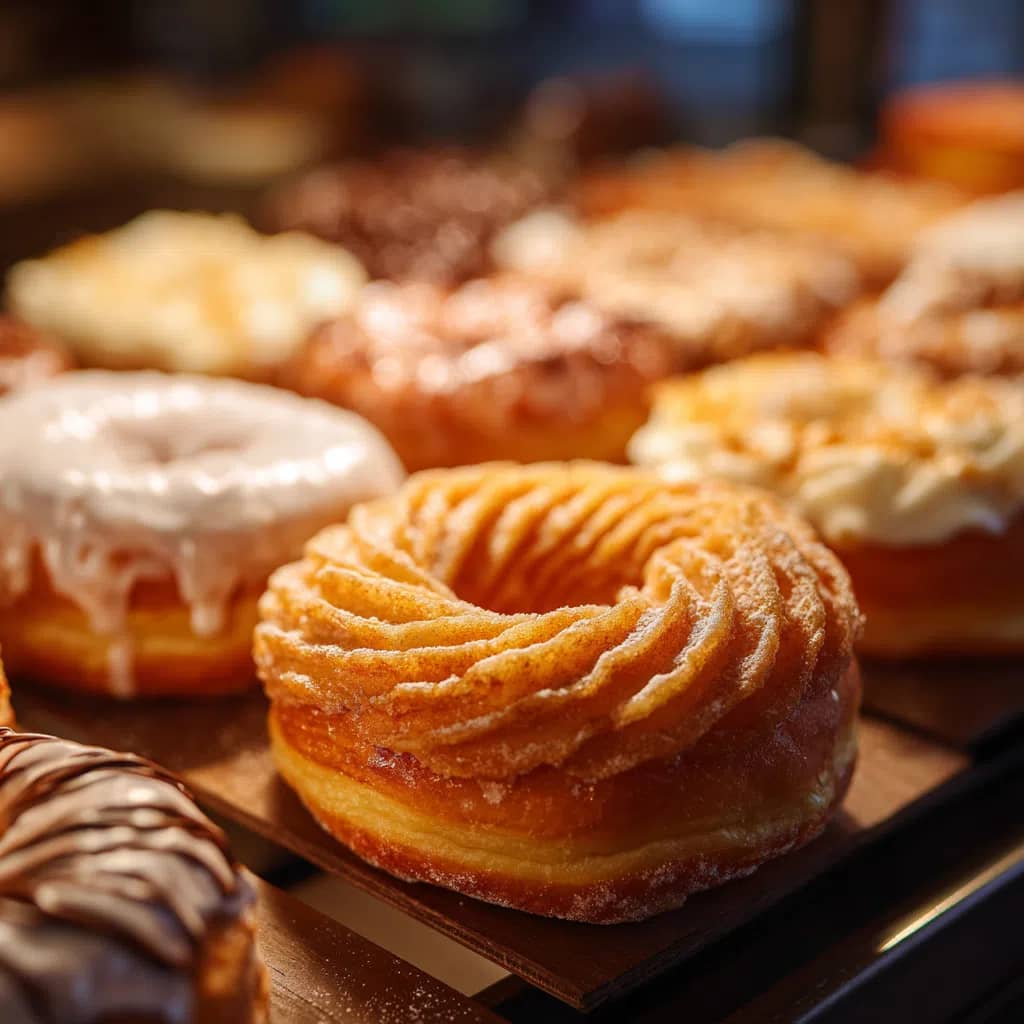
Yes—and the signs are everywhere.
With the rise of nostalgia food and the home baking boom, crullers are coming back in a big way. Just scroll through social media, and you’ll find:
- Instagram reels of home cooks piping perfect rings
- TikTok tutorials on frying French crullers in air fryers
- YouTube chefs testing maple, lemon, and chocolate glaze versions
Food influencers are embracing old-school pastries with new-school flair, and the cruller fits that trend perfectly. It’s Instagrammable, bakeable, and just rare enough to feel special.
There’s even chatter that some bakeries are branding French crullers as “elegant donuts”—giving them upscale appeal.
So whether you find one at your favorite local spot or make a batch from scratch, know this: the French cruller isn’t going anywhere.
In fact, it may be on the verge of becoming the next big thing—again.
FAQs: People Also Ask
The main difference lies in the dough. French crullers are made from choux pastry, which results in a light, airy texture. Traditional donuts use yeast or cake batter, making them denser and heavier. Crullers are crisp on the outside, soft inside, and usually less sweet.
Many large chains like Dunkin’ and Krispy Kreme discontinued the French cruller due to its delicate nature and short shelf life. Choux pastry doesn’t store well, and the cruller’s airy structure loses its texture quickly—making it hard to serve consistently on a mass scale.
The correct pronunciation is “cruh-ler”, not “crawler.” The word comes from the Dutch “krullen,” meaning to curl—referring to the cruller’s twisted, ringed shape.
Some Dunkin’ Donuts locations still offer the French cruller, but it’s not available nationwide. Availability depends on the region and the individual franchise. Your best bet? Call your local store or try making them at home using choux pastry.
To make a classic French cruller, you’ll need choux pastry made from butter, water, flour, and eggs. Pipe the dough into ring shapes using a star tip, then fry until golden. Dip the rings in a light glaze and let them set. See Part 3 above for full instructions!
A cruller is made from pâte à choux, a French pastry dough that includes eggs, butter, water, flour, and a touch of sugar and salt. Unlike traditional donut doughs, it contains no yeast or baking powder—the steam in the dough makes it puff when fried.
Traditionally, crullers are fried, which gives them their signature crispness. However, they can also be baked for a lighter version. Baked crullers won’t be as crisp, but they still maintain their airy interior.
The name blends French technique (choux pastry) with the Dutch-inspired term “cruller”—which means “to curl.” It refers to both the dough’s origin and the cruller’s twisted, ridged shape.
A French cruller tastes light, mildly sweet, slightly eggy, and often has a vanilla glaze. The inside is soft and airy, while the outer ridges provide a gentle crispness. It’s less sweet than a frosted donut and much lighter in feel.
A French cruller tastes light, mildly sweet, slightly eggy, and often has a vanilla glaze. The inside is soft and airy, while the outer ridges provide a gentle crispness. It’s less sweet than a frosted donut and much lighter in feel.
A typical glazed French cruller contains about 220–270 calories, depending on size and glaze thickness. They’re generally lower in calories than filled or frosted donuts, making them a “lighter” indulgence.
French crullers usually contain 10 to 12 grams of sugar, mainly from the glaze. You can adjust the sweetness by using less glaze or swapping it for a dusting of cinnamon-sugar.
Krispy Kreme stopped selling crullers because the choux-based dough is fragile and hard to maintain during mass production. The pastries lose their crisp texture quickly, making them difficult to deliver fresh at scale.
🟩 Conclusion: The French Cruller donut – A Light Donut with Timeless Charm
From the soft custard center to the crisp ridged edges, the French cruller is a pastry that refuses to be forgotten. Whether you miss the ones from Dunkin’, or you’re discovering it for the first time, making crullers at home is easier—and tastier—than most people think.
With a handful of ingredients and a little technique, you can recreate this airy, eggy, melt-in-your-mouth donut in your own kitchen. And with its light sugar glaze and satisfying texture, it’s a dessert that never feels too heavy or too sweet.
So whether you’re a nostalgic donut lover or just craving something uniquely elegant, the French cruller delivers a truly satisfying bite.
Looking for inspiration? Try baking your own batch of French crullers and bring this classic back to life—one golden ring at a time.
🍴 More Recipes
Related Posts
-
Easy Pancake Recipe No Milk (Perfect for All...pancake recipe no milk When you're craving pancakes but find yourself without milk—or simply avoiding…
-
Fluffy Whole Wheat Banana PancakesStart your morning right with these easy, healthy, and fluffy banana pancakes made with whole…
-
Creamy Avocado Toast with Poached Egg and Cherry...Introduction Creamy, fresh, and packed with vibrant colors, this avocado toast recipe takes a beloved…

